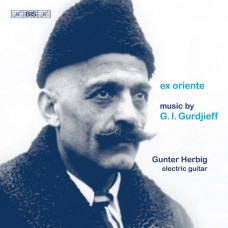|
作為20世紀初偉大的神秘主義者之一,葛吉夫(George lvanovich Gurdjieff)出生於俄羅斯亞美尼亞和土耳其的邊界地區Alexandropol. 他在年輕時期為了追求精神啟蒙, 往東方旅遊遠至西藏, 阿富汗和中亞等地區. 葛吉夫拜訪古老的廟宇, 和精神導師學習並吸收他造訪過地方的音樂. 回到西方世界後, 他的人格魅力吸引了一群追隨者.
追隨者之一的是鋼琴師兼作曲家迪哈特曼(Thomas de Hartmann), 他和葛吉夫獨特的合作下寫出超過三百首鋼琴曲. 葛吉夫會用吉他或鋼琴演奏他的旋律, 迪哈特曼就會寫下來, 加入諧音並配上簡單的伴奏. 吉他手甘特·赫比格年輕時就接觸到葛吉夫的著作和音樂. 數十年來他熱愛將這些作品改編給他的樂器用的想法, 但是一直到他開始嘗試用電吉他演奏才找到合適的作法.
Gunter Herbig, electric guitar
Atmospheric music by the mystic, spiritual leader and composer
One of the great mystics of the early 20th century, George lvanovich Gurdjieff was born
in Alexandropol on the border of Russian Armenia and Turkey. As a young man, he
began to travel east as far as Tibet, Afghanistan and Central Asia, in search of
spiritual enlightenment. Visiting ancient temples, Gurdjieff learned from spiritual
teachers and absorbed music from all the places he visited. On his return to the West,
he gathered a group of followers who were drawn to his charismatic personality.
One of these was the pianist and composer Thomas de Hartmann, and a unique
collaboration between de Hartmann and Gurdjieff ensued which would produce well
over 300 piano pieces. Gurdjieff would play his melodies on the guitar or the piano and de
Hartmann would write them down, harmonize and provide them with
minimalistic accompaniments. The guitarist Gunter Herbig came across Gurdjieff’s
writings and music in his youth. For decades he cherished the idea of transcribing these
pieces for his own instrument, but it wasn’t until he began to experiment with an electric
guitar that he found a way of doing so
.
|



